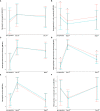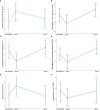Leukocyte cell population data in patients with cardiac surgery and cardiopulmonary bypass: A potential readily available tool to monitor immunity
- PMID: 36741408
- PMCID: PMC9892932
- DOI: 10.3389/fimmu.2022.1101937
Leukocyte cell population data in patients with cardiac surgery and cardiopulmonary bypass: A potential readily available tool to monitor immunity
Abstract
Purpose: Cardiac surgery with cardiopulmonary bypass triggers sterile inflammation that is responsible for post-operative morbidity. Automated flow cytometry devices used for leucocyte count provide cell population data (CPD) regarding fluorescence intensity, size and granularity of leukocytes that have never been studied in the context of sterile inflammation. Our objective was to explore leukocyte cell population data in patients undergoing cardiac surgery with cardiopulmonary bypass in order to determine whether CPD could be used to monitor immune cell activation.
Methods: This is an ancillary study of a cohort of patients undergoing cardiac surgery with cardiopulmonary bypass. Cell population data (CPD) extracted from a routine automated flow cytometer were analyzed (Fluorescence targeted to nucleic acids). The time points of interest were: pre-operative, postoperative and 5 days after surgery. The variations in those parameters were studied. Data were then compared between patients according to the occurrence of a composite criteria (supra-ventricular arrythmia, stroke, acute renal failure, and/or death).
Results: Data from 1453 patients were analyzed. The neutrophil count, fluorescence granularity (NE-SCC), intensity (NE-SFL) and size (NE-FSC) increased with surgery. Heterogeneity of neutrophils decreased in terms of fluorescence granularity (NE-WX) and size (NE-WZ) but increased in terms of intensity (NE-WY). The lymphocyte count decreased with surgery. While fluorescence granularity (LY-X) and size increased (LY-Z), Lymphocyte intensity decreased (LY-Y). Lymphocytes were less heterogeneous in terms of their granularity, size and intensity after surgery (LY-WX, LY-WY, LY-WZ). Patients who developed the composite complication criteria had a higher pre-operative neutrophil count (5.08 [3.89;6.95] vs 4.76 [3.60;6.13], p = 0.02; AUC = 0.56 [0.51;0.60]), and more heterogeneous neutrophils in terms of fluorescence granularity (NE-WX, AUC = 0.57 [0.52;0.62]) and intensity (NE-WY, AUC 0.61 [0.56;0.65]). Those patients also had lower pre-operative lymphocyte count (1.49 [1.10;1.14] vs 1.81 [1.39;2.39], p<0.01, AUC = 0.61 [0.57;0.66]) and fluorescence granularity (LY-X, AUC = 0.57 [0.53;0.62]). NE-WX, NE-WY and LY-X were associated with post-operative complications after adjustment on the EuroSCORE 2 (adjusted odd ratio of 1.01 [1.00;1.02]; 1.01 [1.00;1.01] and 1.08 [1.02;1.15] respectively).
Conclusion: Cardiac surgery with cardiopulmonary bypass was associated with substantial alterations of CPD probably reflecting leukocytes activation in sterile inflammation. Pre-operative NE-WX, NE-WY and LY-X biomarkers levels were associated with post-operative complications, independently of the EuroSCORE 2. Such routine, unexploited and low cost parameters might represent useful tools likely to monitor immune function and predict outcomes for patients undergoing cardiac surgery. Our findings requires validation on a larger external cohort.
Keywords: acute kidney injury; biomarker; cardiac surgery; cardiopulmonary bypass; cell population data; immunity; inflammation; post-operative outcome.
Copyright © 2023 Nguyen, Stiel, Guilloteau, Bahr, Masson, Thomas, Blot, Guy, Fontaine, Durand, Bouhemad and Guinot.
Conflict of interest statement
The authors declare that the research was conducted in the absence of any commercial or financial relationships that could be construed as a potential conflict of interest.
Figures





References
-
- von Elm E, Altman DG, Egger M, Pocock SJ, Gøtzsche PC, Vandenbroucke JP, et al. . The strengthening the reporting of observational studies in epidemiology (STROBE) statement: Guidelines for reporting observational studies. PloS Med (2007) 4:e296. doi: 10.1371/journal.pmed.0040296 - DOI - PMC - PubMed
MeSH terms
LinkOut - more resources
Full Text Sources
Medical
Research Materials

